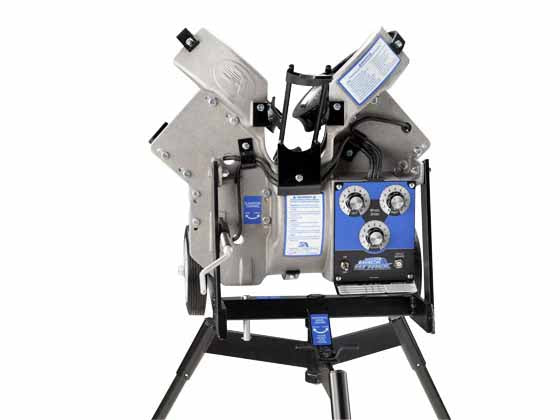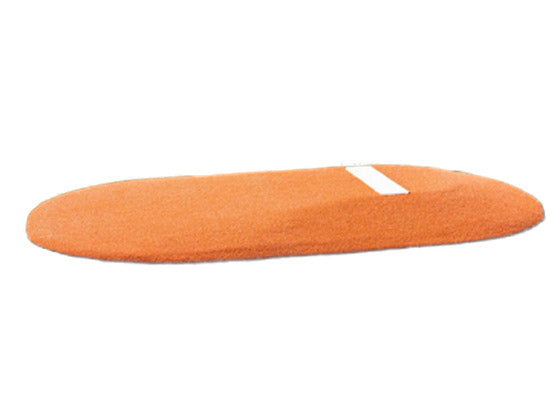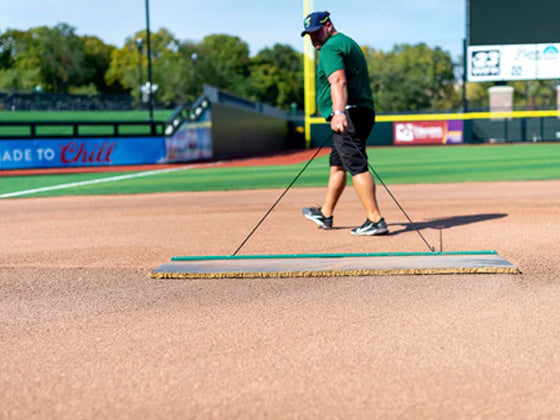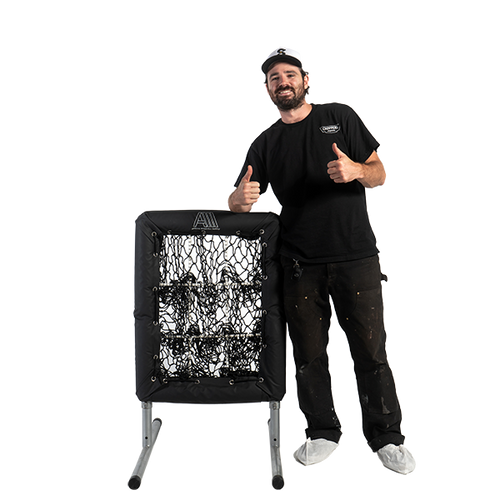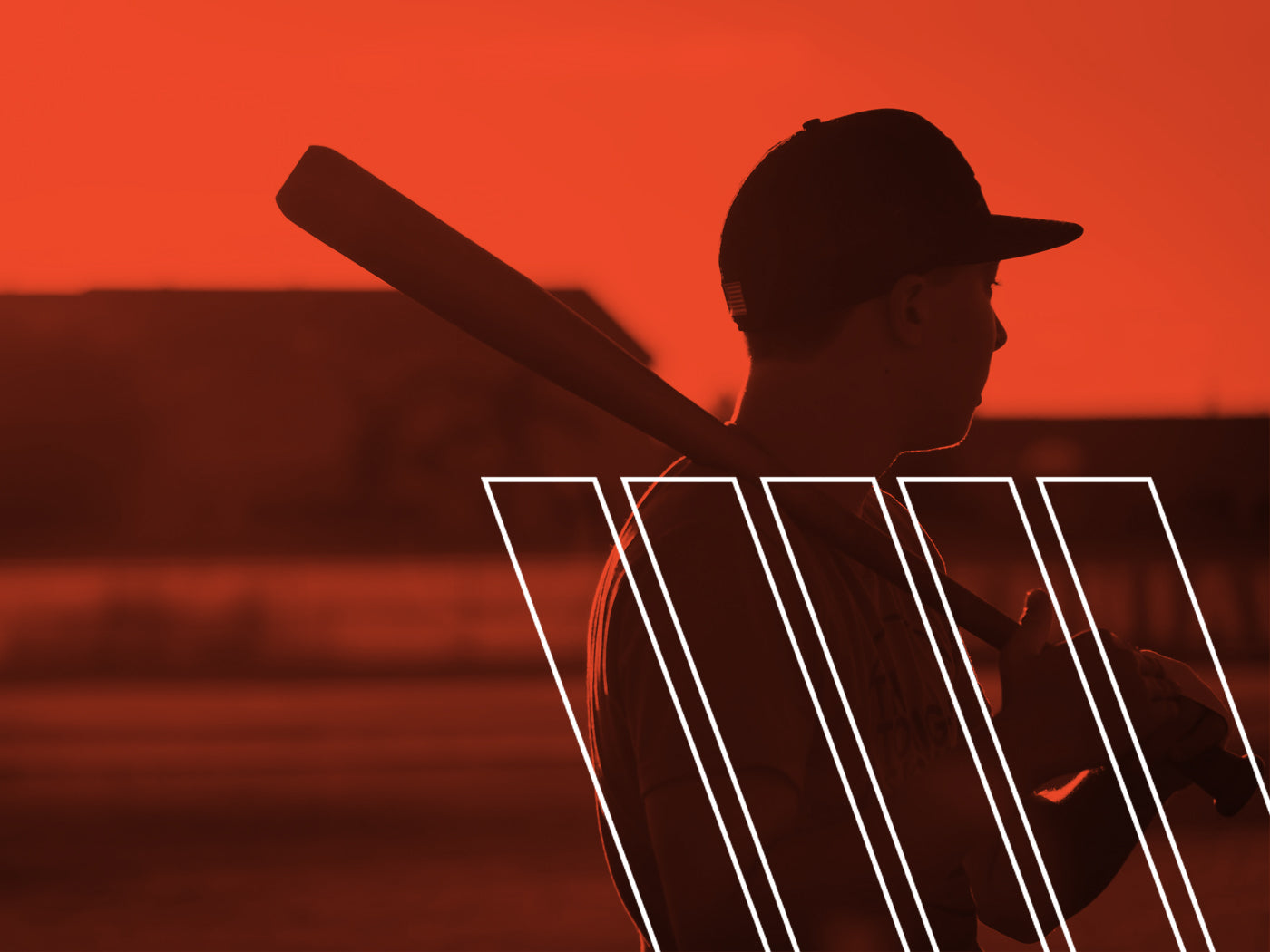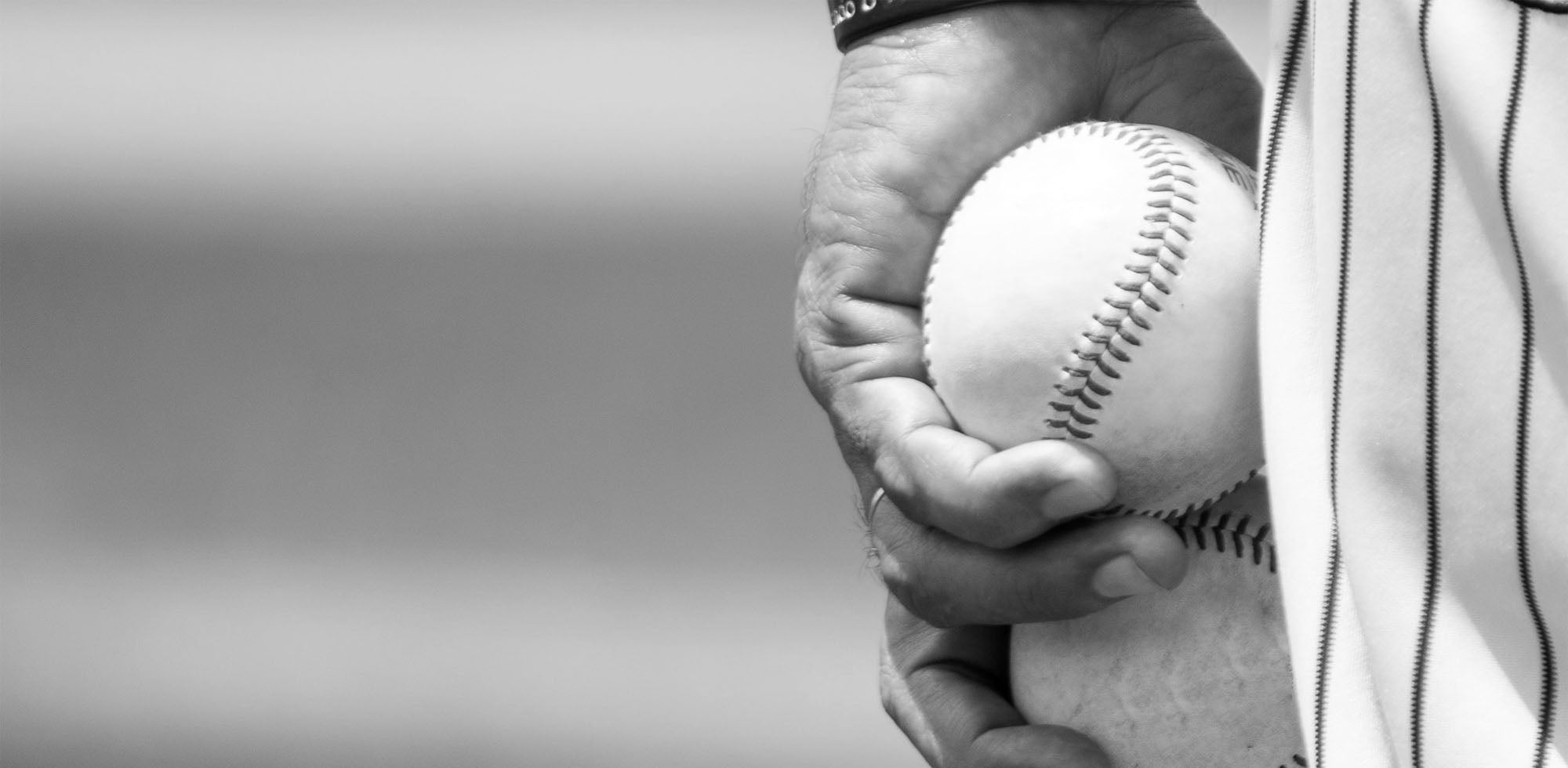This is the most comprehensive guide to finding and purchasing the right portable pitching mound for your youth league team. It covers everything you need to know about portable pitching mounds, from mound size to construction and everything in between.
Read on and find the perfect portable pitching mound for your kids.
What is a portable pitching mound?
A portable pitching mound is a great training tool and a valuable asset to any field or facility. It will save you time and money and give your players a competitive edge for many seasons.
Why do you need a portable pitching mound?
Maintaining a dirt pitching mound is time-consuming and typically requires a dedicated groundskeeper.Before and after every game, the dirt mounds must be inspected and rebuilt using the field to the league’s specifications.
This is extremely time-consuming, especially since every league has its own mound dimension requirements, and some baseball fields host multiple games daily.
(Building a dirt pitching mound is time-consuming and requires a groundskeeper on staff).
For these reasons, portable pitching mounds instantly became a huge hit in the baseball community. Shortly after the first portable pitching mounds were produced, many high schools, parks and recreation centers, leagues, and even baseball parents began buying them like crazy.
Suddenly, a baseball field could host several games in a single day, catering to the needs and specific mound dimensions of more than one league.
Also, since most portable mounds weigh less than a few hundred pounds, it only takes a few parents or staff members to switch out the mound for a new league’s mound.
Overall, a properly built portable mound will:
- Drastically improve any pitcher’s skills.
- Promote proper pitching mechanics.
- Create a safe pitching environment.
- Save you time and money over the years to come.
Tip: Pitching from a cheap mound or a mound with the wrong dimensions can be dangerous for young players. Some portable mounds built with styrofoam or wood become squishy over time and develop dead spots. These mounds are dangerous and will teach kids poor pitching mechanics.
Therefore, purchase a quality mound that will not deteriorate over time.
It is also imperative that there is consistency with pitching-mound dimensions between practice and games.
If a player practices pitching from flat ground, level to home plate, then starts a game on a new field with a mound 8” taller than home plate, they will have difficulty adjusting and not pitch at their best.
Ensure the mound dimensions remain consistent between practice and games for optimal pitching performance.
How to Choose the Right Pitching Mound Type
There are three types of portable pitching mounds:
- Game mounds,
- Indoor practice mounds, and
- Pitching platforms.
Although they are all designed to improve a pitcher’s pitching skills, each has its application.
Game Pitching Mounds
Game mounds are designed for precisely what they sound like: games and tournaments. They are portable and typically designed for outdoor use only. This means the turf is extra durable and usually treated with a UV-resistant layer.
Indoor Practice Pitching Mounds
Indoor practice mounds are great for indoor facilities like gyms or batting cages. They’re also portable and designed to help pitchers improve their pitching skills despite the weather.
For this reason, we recommend purchasing an indoor pitching mound during the winter to keep your pitching skills sharp during the off-season.
A good indoor practice mound should be able to grip a slick gym floor and not move around with every pitch delivered. Some indoor mounds are rough on the bottoms and will move around and scratch a gym floor! Be sure your new indoor mound won’t scratch the gym floors and will grip well.
Another great feature we love about indoor mounds is the two-piece design. Our favorite indoor mound brand, PortoLite, does a great job creating this design. This design allows for easy storage and portability and the ability to stagger the mound, giving the front foot more landing area (see image below).
Pitching Platforms
Pitching platforms have the same features as both game mounds and practice mounds. They’re generally used outdoors on a field as a game mound, but for practice, they’re like an indoor mound. And, like the other mounds, the platforms come with turf or a turf equivalent and are sloped downward.
The beauty of pitching platforms is that they are generally less expensive than game and practice mounds while still being lightweight and portable. Many platforms include built-in wheels, which simplify transport before and after games.
Now that we understand the different types of pitching mounds and platforms, let’s determine the size of the mound you need!
What size of portable pitching mound do I need?
The right mound height primarily depends on the age group of the players:
- Ages 6-9: A 4-inch tall pitching mound
- Ages 9-11: A 6-inch-tall mound.
- Ages 12-14: An 8-inch tall mound
- High School and Above (Ages 15+): A 10-inch tall mound aligns with regulations for high school, college, and professional levels.
Other factors to consider are:
1. Doing Pickoffs with Your Portable Pitching Mound
Another thing to consider when evaluating the size of a pitching mound is whether or not the mound is big enough for pickoffs. If you want to teach your kids how to do pickoffs properly, purchase a mound with enough room around the pitching rubber for the pitcher to work with.
Some of our popular full-size youth mounds, like the True Pitch 312-G portable pitching mound and Pitch Pro 1810 pitching mounds, have plenty of room for pitchers to pick off players at any base.
If these full-size mounds are out of the budget or just too big, don’t fret; we have other mounds that are a bit smaller and still offer the same benefits as the full-size mounds for pickoffs.
Take a look at the Pitch Pro 796 portable pitching mound, for example. Although the pitcher’s front foot will land on the flat ground, there is still plenty of room around the pitching rubber for the pitcher’s foot to work with.
2. Pitching Mound Construction and Durability
Now that we understand mound sizes, age and skill levels, and types, let’s see what some leading portable mound manufacturers build their mounds out of!
i. Pitch Pro pitching mound construction:
Pitch Pro mounds are the most rigid and durable mounds on the market. Pitch Pro decided to go with a more rigid structure to emulate the realistic feeling of a packed dirt mound and to avoid the “dead spots” that other mounds develop over time.
These mounds are built with quality turf and finished with a UV and weather-resistant coating.
Watch how Pitch Pro builds its industry-leading pitching mounds!
ii. Allstar mound construction:
Our most popular mounds, AllStar Mounds, are constructed with durable fiberglass and are layered with AstroTurf. Their fiberglass makes for a lightweight and durable mound. No styrofoam or wood materials are used to manufacture Allstar mounds, which sets them apart from most other pitching mound manufacturers.
iii. PortoLite pitching mound construction:
PortoLite manufactures some of the most lightweight and durable mounds on the market, using only the highest quality fiberglass and AstroTurf. The mounds feature a solid, but not bouncy, cushioned landing that closely imitates a real dirt mound and promotes a safe pitching environment.
iv. True Pitch pitching mound construction:
Another popular pitching mound manufacturer, True Pitch, produces the only pitching mounds that Little League approves for game and tournament use. True Pitch mounds also utilize high-quality fiberglass and are finished with AstroTurf.
These are just a few of the premier pitching mound brands we carry. Most offer high-quality construction—otherwise, we wouldn’t carry them!
Note: The common denominator is that a durable pitching mound should be built with high-quality fiberglass and firm turf or AstroTurf. Make sure wood and styrofoam are not used in the production of the mound you are looking to purchase, as these mounds tend to fall apart and develop "dead spots" over time.
3. Transportation and Storage: Don’t Overlook the Practical Stuff
Before you hit that “add to cart” button, think about where your mound is going—and how it’s getting there. Portability is a big deal if you’re coaching a travel team or working with limited storage space (think school equipment sheds).
Some mounds, like the ones from True Pitch, come with built-in handles or wheels that make moving them a breeze. Others, like AllStar mounds, are built with lightweight fiberglass, which means less back strain when loading up for an away game. Even better? Some models break down into two or three pieces so you can slide them into the back of a minivan or SUV without a game of Tetris.
Remember that heavier mounds tend to be more stable and feel closer to the real deal—but they’re definitely not as easy to move around. So, weigh your priorities (pun intended) and choose a model that fits your team’s lifestyle.
4. Budget and Long-Term Value: Spend Smart, Not Cheap
We get it—no one wants to drop a ton of cash upfront. But when it comes to portable pitching mounds, you get what you pay for.
Most quality mounds range from $700 to $18,000 or more, depending on size, material, and features. That might sound like a lot, but investing in a premium mound—like those from Pitch Pro or PortoLite—means you’re getting something built to last season after season. Cheaper models might save you a few bucks today but could wear out by next year.
If your team’s budget is tight, consider splitting the cost among players or reaching out to local businesses for sponsorship. A little teamwork goes a long way; your pitchers will thank you.
And don’t forget: a little TLC can make your mound last even longer. Store it indoors, clean the turf regularly, and steer clear of metal cleats. Your investment—and your mound—will go the distance.
Side note about "spike-proof" turf
Despite what some people may say, there is no such thing as spike-proof turf. We called the biggest pitching mound and turf companies and asked for their expertise. They all agreed there is no such thing as a spike-proof mound and that metal cleats will ruin a turf mound over time.
If someone tells you their mounds are spike-proof, take it with a grain of salt. They probably mean that the mound is spike resistant, meaning that it can resist metal spikes for a period of time but not indefinitely.
Please be sure that only plastic or rubber spikes are used on your portable mound!
Note: Metal cleats cut deep into the fibers that keep turf together and will eventually break it apart, ruining your mound. This is why turf manufacturers do not extend warranties to pitching mounds.
5. Pitching Mound Warranties - How Long is Long Enough?
Every manufacturer offers different types of warranty on the pitching mounds they make. Let’s see what kind of warranties some leading portable pitching mound manufacturers offer!
1. Allstar Mounds:
Allstar Mounds are manufactured in the USA and backed by a three-year manufacturer’s warranty on the fiberglass shell.
2. Pitch Pro pitching mounds:
Pitch Pro mounds are backed by a 10-year manufacturer’s warranty on the mound core. This is the most extended pitching-mound warranty we have seen in the industry. It’s no wonder they are so popular!
3. True Pitch pitching mounds:
True Pitch is one of the oldest names in portable pitching mounds and offers a 6-year warranty on mound fiberglass. Backed by a strong brand name and a warranty, you can’t go wrong!
4. PortoLite pitching mounds:
PortoLite now offers a 10-year manufacturer’s warranty on the manufacturer’s defect. With a durable design and a 10-year warranty, this is a no-brainer.
Overall, we recommend a 2-year manufacturer’s warranty on any portable mound you purchase.
Note About the Warranty on Turf: Unfortunately, there are no warranties on turf or AstroTurf. Turf companies do not extend warranties to any pitching mounds. However, we do offer some replacement turf kits for select pitching mounds.
5. Pitching Mound Color - What color should we pick for our field?
Typically, pitching mounds are sold in clay or green. We have found that our clay models sell much better because they more closely resemble regulation MLB pitching mounds.
Real pitching mounds are just dirt built to a particular specification, so customers usually prefer the clay/ dirt color.
However, some people prefer green because it looks like grass and fits their field’s aesthetic. The pitching mound color is a preference and is entirely up to you!
6. Pitching Mound Safety
When looking for the proper mound for your kid or youth league team, make sure that it is safe. One of the biggest safety concerns with portable pitching mounds is the lip on the edges.
Some mounds’ edges start to stick up over time, which can be a safety issue for the pitcher. Make sure that the mound you purchase has tapered edges and that the lip doesn’t stick out. Any edges that stick out may worsen as people step on them. As the lip sticks out, the more dangerous the mound becomes.
Tip: Move dirt around the mound’s tapered edges to reduce the lip’s size for the pitcher’s safety and the mound’s longevity.
Common Mistakes to Avoid When Buying a Portable Pitching Mound
1. Prioritizing Price Over Quality
Cheaper mounds may seem like a good deal upfront, but they often wear out faster. Spending more initially can save money in the long run. Investing in better quality means fewer repairs, better performance, and a longer lifespan.
2. Choosing an Incorrect Size
If you pick a mound that’s too small, your pitchers won’t get the right stride or feel. If you go too big, it’s a hassle to move or store. Always match the mound size to your players’ age group and your training space. It’ll make a big difference in both safety and development.
Read more: Pitching machine height by age and league.
3. Not Considering Transportability
Heavier mounds offer better stability but can be tough to move, especially without wheels or a trailer. If you’re coaching a travel team or using shared facilities, look for lighter models or ones with built-in handles and wheels. It’ll save your back—and your schedule.
What are the top portable pitching mound brands?
Some of the most trusted names in portable mounds include Portolite, Pitch Pro, True Pitch, and AllStar Mounds. Each brand brings something different to the table— durability, portability, or game-like performance. These brands are widely used by coaches at all levels.
The Brands We Recommend
|
Model |
Age Range |
Mound Size |
Best for |
|
PortoLite 4`` Portable Youth Pitching Mound |
6 - 9 |
4`` |
Little league, pony league, etc |
|
8 - 12 |
6`` |
Little league |
|
|
12 - 14 |
8`` |
High school |
|
|
15+ |
10`` |
High Schools, Colleges, Senior Leagues, etc. |
Portable Mound Accessories and Add-ons
i. What Turf Options Improve Performance?
Some mounds have premium turf that offers better traction and durability, especially under rubber cleats. Look for turf that’s UV-resistant, easy to clean, and securely bonded to the surface. It’ll hold up better over time and give pitchers a more consistent feel.
ii. Are Carrying Cases or Covers Worth the Investment?
Covers and cases are a no-brainer if you’re storing your mound outdoors or hauling it to different locations. They protect your investment from weather, dirt, and wear and make transportation much smoother—especially for multi-piece mounds.
iii. Which Training Aids Complement Your Portable Mound?
Consider pairing your mound with stride mats, pitching rubbers, and radar guns for more effective training. Tools like pitching targets or plyo balls can also help pitchers build strength, improve mechanics, and stay locked during bullpen sessions.
Final Words
Nowadays, there are plenty of quality portable pitching mounds to choose from, making your search for the right pitching mound as simple as ever.
As mentioned earlier, the most important things to understand before placing your order on your first portable mound are the mound types, size, age and skill level, color, construction, and warranty.
A quality portable mound will last many seasons and save time building and maintaining a dirt mound. Watch your kid or youth team reap the benefits of a properly built bank and develop a competitive edge over their competition over the seasons to come.
We hope you got value from this article and feel informed enough to make a buying decision on your next portable mound. And now we’d like to hear from you:
- What did you like or dislike about this article?
- Are you ready to purchase a portable mound, or do you still have questions?
If this article helped you purchase a mound, let us know how it helped and which mound you decided to buy! Let us know, and leave us a comment below right now!

 Contact Us
Contact Us